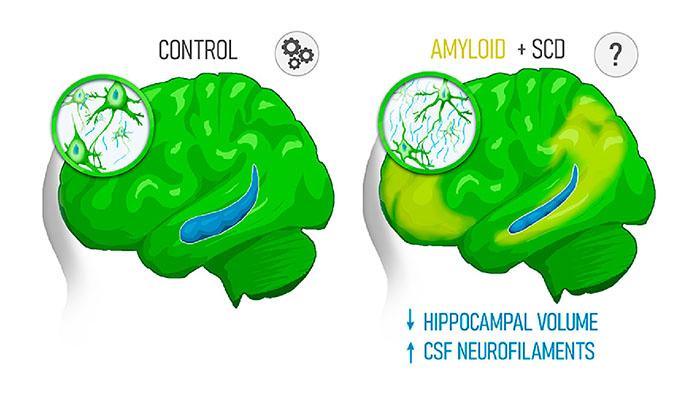13 Jul | 2021
Identified a new association between light neurofilaments and other markers of Alzheimer's disease

Summary infographic of the finding
Researchers at the Barcelonaβeta Brain Research Center (BBRC) have identified that people with amyloid pathology and subjective cognitive impairment have an increase in light neurofilaments (NfL) in the cerebrospinal fluid and a lower volume in the hippocampus. The research was made possible by participants in the Alfa + Study, promoted by the ‘la Caixa’ Foundation, and published in the journal Neurobiology of Aging.
Light neurofilaments are filaments that are involved in maintaining the structure of neurons and axons. In the field of neurodegenerative disease research, they are a promising biomarker of neuronal damage, as when neurons die, neurofilaments are released and their amount increases in the cerebrospinal fluid. The aim of this study was to measure the levels of this biomarker in cerebrospinal fluid to analyze whether there are associations with the presence of other markers of risk of developing Alzheimer's disease, such as subjective memory complaints, brain structure and plaque accumulation of Beta-Amyloid protein.
"The results of our study support the use of light neurofilaments as more accurate indicators of neurodegeneration than other methods known today," says Dr. Gonzalo Sánchez, first author of the research and researcher in the Clinical Research, Biomarkers and Risk Factors group at the BBRC. The study, he adds, "also opens the door to identify subjects at particular risk of entering the symptomatic phase of Alzheimer's disease."
The study involved 278 people between the ages of 45 and 75 without cognitive impairments, who underwent various clinical tests, cognition, neuroimaging and a lumbar puncture to extract cerebrospinal fluid, among others.
After analyzing all the tests and taking into account other variables such as age, sex, mood and cardiovascular risk, the researchers concluded that neurofilament levels are increased in the cerebrospinal fluid of people who present subjective complaints of memory and especially in people with complaints and amyloid pathology in the brain. In addition, only in this subgroup of people, a higher level of neurofilaments is associated with a lower volume of the hippocampus, which is one of the first areas of the brain to be affected by Alzheimer’s disease.










